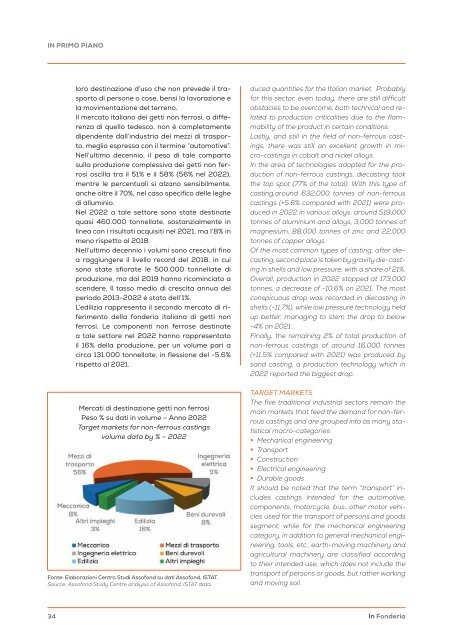In Fonderia 3 2023
Terzo numero del 2023 di In Fonderia
Terzo numero del 2023 di In Fonderia
Create successful ePaper yourself
Turn your PDF publications into a flip-book with our unique Google optimized e-Paper software.
IN PRIMO PIANO<br />
loro destinazione d’uso che non prevede il trasporto<br />
di persone o cose, bensì la lavorazione e<br />
la movimentazione del terreno.<br />
Il mercato italiano dei getti non ferrosi, a differenza<br />
di quello tedesco, non è completamente<br />
dipendente dall’industria dei mezzi di trasporto,<br />
meglio espressa con il termine “automotive”.<br />
Nell’ultimo decennio, il peso di tale comparto<br />
sulla produzione complessiva dei getti non ferrosi<br />
oscilla tra il 51% e il 58% (56% nel 2022),<br />
mentre le percentuali si alzano sensibilmente,<br />
anche oltre il 70%, nel caso specifico delle leghe<br />
di alluminio.<br />
Nel 2022 a tale settore sono state destinate<br />
quasi 460.000 tonnellate, sostanzialmente in<br />
linea con i risultati acquisiti nel 2021, ma l’8% in<br />
meno rispetto al 2018.<br />
Nell’ultimo decennio i volumi sono cresciuti fino<br />
a raggiungere il livello record del 2018, in cui<br />
sono state sfiorate le 500.000 tonnellate di<br />
produzione, ma dal 2019 hanno ricominciato a<br />
scendere. Il tasso medio di crescita annua del<br />
periodo 2013-2022 è stato dell’1%.<br />
L’edilizia rappresenta il secondo mercato di riferimento<br />
della fonderia italiana di getti non<br />
ferrosi. Le componenti non ferrose destinate<br />
a tale settore nel 2022 hanno rappresentato<br />
il 16% della produzione, per un volume pari a<br />
circa 131.000 tonnellate, in flessione del -5.6%<br />
rispetto al 2021.<br />
Mercati di destinazione getti non ferrosi<br />
Peso % su dati in volume – Anno 2022<br />
Target markets for non-ferrous castings<br />
volume data by % – 2022<br />
Fonte: Elaborazioni Centro Studi Assofond su dati Assofond, ISTAT.<br />
Source: Assofond Study Centre analysis of Assofond, ISTAT data.<br />
duced quantities for the Italian market. Probably<br />
for this sector, even today, there are still difficult<br />
obstacles to be overcome, both technical and related<br />
to production criticalities due to the flammability<br />
of the product in certain conditions.<br />
Lastly, and still in the field of non-ferrous castings,<br />
there was still an excellent growth in micro-castings<br />
in cobalt and nickel alloys.<br />
<strong>In</strong> the area of technologies adopted for the production<br />
of non-ferrous castings, diecasting took<br />
the top spot (77% of the total). With this type of<br />
casting,around 632,000 tonnes of non-ferrous<br />
castings (+5.6% compared with 2021) were produced<br />
in 2022 in various alloys: around 519,000<br />
tonnes of aluminium and alloys, 3,000 tonnes of<br />
magnesium, 88,000 tonnes of zinc and 22,000<br />
tonnes of copper alloys.<br />
Of the most common types of casting, after diecasting,<br />
second place is taken by gravity die-casting<br />
in shells and low pressure, with a share of 21%.<br />
Overall, production in 2022 stopped at 173,000<br />
tonnes, a decrease of -10.6% on 2021. The most<br />
conspicuous drop was recorded in diecasting in<br />
shells (-11.7%), while low pressure technology held<br />
up better, managing to stem the drop to below<br />
-4% on 2021.<br />
Finally, the remaining 2% of total production of<br />
non-ferrous castings of around 16,000 tonnes<br />
(+11.5% compared with 2021) was produced by<br />
sand casting, a production technology which in<br />
2022 reported the biggest drop.<br />
TARGET MARKETS<br />
The five traditional industrial sectors remain the<br />
main markets that feed the demand for non-ferrous<br />
castings and are grouped into as many statistical<br />
macro-categories:<br />
• Mechanical engineering<br />
• Transport<br />
• Construction<br />
• Electrical engineering<br />
• Durable goods<br />
It should be noted that the term “transport” includes<br />
castings intended for the automotive,<br />
components, motorcycle, bus...other motor vehicles<br />
used for the transport of persons and goods<br />
segment; while for the mechanical engineering<br />
category, in addition to general mechanical engineering,<br />
tools, etc., earth-moving machinery and<br />
agricultural machinery are classified according<br />
to their intended use, which does not include the<br />
transport of persons or goods, but rather working<br />
and moving soil.<br />
34<br />
<strong>In</strong> <strong>Fonderia</strong>














